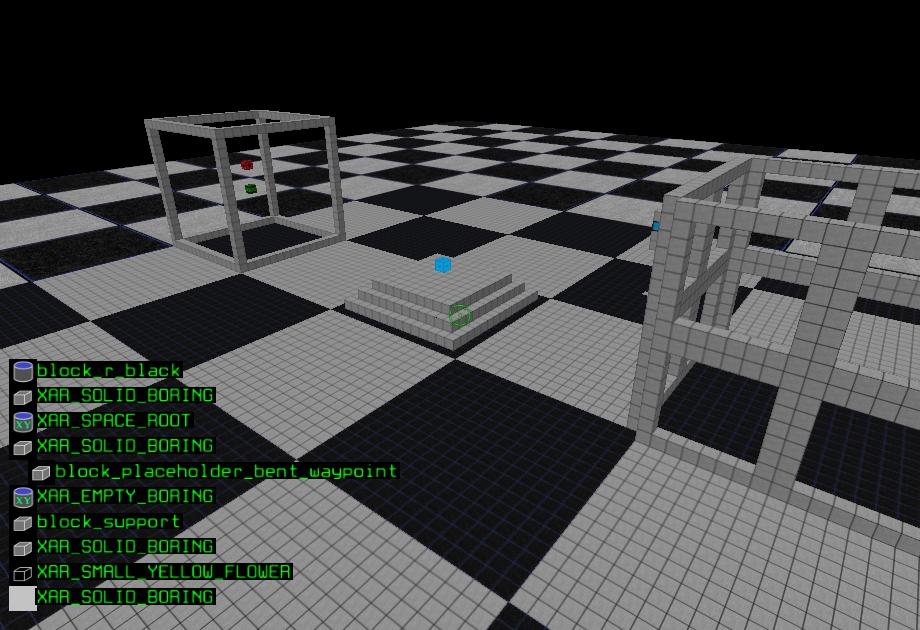Xar Chunk Edit Package

Back
What This Package Does
This is a package which you can use to create your own Lua block script,
to be used in your own Fractal Block World package.
A block script, let's say which is called
block_simple_room.lua, might look something like the following:
function p.__get_is_solid()
return true
end
function p.__get_tex()
return "block_checkered"
end
function p.__main()
-- The default block is the "empty block".
set_default_block("e")
--Adding a pillar.
create_rect("s", 7,7,0, 7,7,15)
--A tree on the ground.
set_pos(3,3,0, "block_tree")
-- Shrinking.
add_bent(3,3,2, "bent_base_ring_green")
-- Text box.
local msg_str = "Hello."
add_bent_s(9,9,6, "bent_base_txt", msg_str)
end
It is intended that you write these Lua block scripts by hand.
Indeed, to do certain complicated things like have randomness,
it makes sense to write them by hand.
Note that all chunks in the xar package were written by hand.
However, some chunks have no randomness and could be called
"custom structures".
For example, you might want a chunk that contains a
modern art sculpture.
The associated block script would likely have many
set_pos lines in it.
Writing this by hand can be tedious.
The purpose of this package is to allow you to edit
the chunk in the game, and then save the chunk you are
editing to a Lua block script.
That is, the package takes blocks built by the player
and uses this to auto generate Lua code.
How to Install the Package
To install, simply download the
xar_chunk_edit package here,
extract the zip file and put the directory xar_chunk_edit
in the directory Data/Packages/.
So you will have the directory
Data/Packages/xar_chunk_edit.
Start the Fractal Block World program and start
a new game that uses the xar_chunk_edit package.
The rest of this page describes how to use the package.
Changing Movement Speed
By pressing the Q key
or the E key
you can change the speed at which you move around.
10 "Weapons"
While playing the game (for this package),
there are 10 "weapons" you can use.
You select a weapon by pressing a number key
(0 through 9) or by using your mouse wheel.
Select a Block Type
Every weapon has a "block type" associated to it.
You can select a block type for a weapon
by first having the weapon equipped and pressing
the T key.
Then go to "SELECT BLOCK TYPE".
You will be asked to choose between selecting a
"xar block type" or a "non-xar block type".
The non-xar block types are associated to the block
lua scripts in Data/Packages/xar_chunk_edit/WorldNodes/Nodes.
The xar block types are the blocks that are built into
the engine (they are specified by C++ code that you do
not have access to).
Note that when selecting a block type from a list,
you can type a "search string".
Only the block types that match that string will be
listed.
There is another way to select the block type
for a weapon.
While you have the weapon selected, hold down the
G key
and left click on a block.
That will select the type of that block.
Alternatively, you can hold down the G key
and right click on a block.
This will select the block type of the empty block
that is adjacent to the block that you are looking at.
Select a Tool Type
Each of your 10 weapons has a "tool type".
You change this by first selecting a weapon,
pressing the T key,
and going to "SELECT TOOL TYPE".
Left vs Right Clicking
You use a weapon by either left clicking or right clicking.
These do different things.
Left clicking generally does something to the solid block you
are looking at.
For example, it might replace it with the block type
of the weapon.
Right clicking generally does something to the empty block that
is adjacent to the one you are looking at.
Taking a Snapshot of a Chunk
Once you have created blocks in whatever chunk you want,
you can fly into the chunk, open the console and enter the command
snap.
This will take the chunk you are in and auto generate the following
Lua file:
Output/FileOut/chunk_snapshot.lua
You can then take the file, change its name, modify its code slightly,
and put it in the WorldNodes/Nodes directory of whatever
package you are creating yourself.
Take a look at the following file to see how the snap command works:
Data/Packages/xar_chunk_edit/Game/Commands/game_cmd_snap.lua
Feel free to modify the game_cmd_snap.lua file to make it
behave the way you want.
Note that the snap command will merge adjacent blocks together
of the same type to create rectangles of blocks.
The Support Block
The block of type block_support is special.
It is solid, but when you take a snapshot, it is not
saved.
Placeholder Blocks
Any block whose name starts with block_placeholder
is special.
These are called "placeholder blocks".
When you take a snapshot, these are not saved normally, but instead the
placeholder_for(x,y,z) function of the block script is called to generate
an alternate Lua code line for the block.
For example, consider "block_placeholder_bent_shrink.lua":
function p.__get_is_solid() return true end
function p.__get_tex() return "xce_placeholder_shrink" end
function p.__main()
set_default_block("r_black")
end
function p.placeholder_for(x,y,z)
return
"add_bent("
.. tostring(x) .. ","
.. tostring(y) .. ","
.. tostring(z) .. ","
.. " \"bent_base_ring_green\")"
end
If we have this placeholder block at position (1,3,4),
then the corresponding line in the chunk_snapshot.lua
file will be as follows:
add_bent(1,3,4, "bent_base_ring_green")
That is, there will be green shrink rings
in the location that the placeholder block used to be.
Feel free to create your own placeholder blocks.

